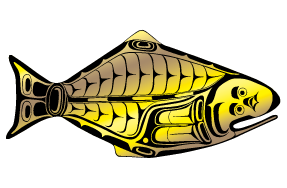Like many marine fish, Pacific halibut are susceptible to parasites. Studies by Blaylock et al. (1998) identified 59 parasite taxa from 536 individual Pacific halibut examined. The parasites are largely ecological generalists and can be found among a wide variety of marine fishes, albeit the parasite community in Pacific halibut is more similar to other flatfishes in similar ecological niches. Parasite loads increase to about the age of 6 years, coincident to their counter-migration and shift in diet and therefore exposure to different parasite populations. Pacific halibut with more individual parasites tend to be slightly smaller than other Pacific halibut from the same age class, indicating that parasite loads can be a cause of morbidity in this species. The parasite community of a given animal can be used to roughly group it into one of three zoogeographic zones of origination (with boundaries near Kodiak Island, and southern Haida Gwaii), although the edges of these zones are somewhat diffuse, likely due to mobility and migration of both the hosts and the parasite community itself.
Ichthyophonus in Pacific halibut
Ichthyophonus is an internal histozoic parasite (i.e. present within the host’s tissues) that is known to infect multiple fish species throughout the Northern Atlantic and Pacific Oceans. It affects the energy budget of certain infected animals and increases mortality, and in some parts of the world Ichthyophonus has been implicated in major collapses of herring populations. The parasite grows in the internal organs of a fish and is usually not detectable by the naked eye. However, after severe infections, white node-like lesions may be visible on the liver and heart. Ichthyophonus is not harmful to humans.
The IPHC and the U.S. Geological Survey began studying Ichthyophonus in 2011, and over a five-year period (2011-2015), infections in Pacific halibut were detected at relatively high prevalence (23.7 to 76.7%) compared to other host species. Inter-annual infection prevalence was relatively stable within geographic locations. Between 2011 and 2015 infection prevalence was 26.2-37.3% in the Bering Sea, 58.3-76.7% in Prince William Sound, and 16.7-50% off the coast of Oregon. Spatial differences were detected, with significantly higher infection prevalence occurring in Prince William Sound than in other locations tested. Infection prevalence did not vary with sex but did vary with age. In 2012, infections were detected in only 1.4% of Pacific halibut less than 7 years old, suggesting that exposure to the parasite may coincide with an ontogenetic shift in diet or habitat. Ichthyophonus schizonts (dormant spore) were detected in only eight of 331 histology sections from Pacific halibut that tested positive for the parasite in heart culture assays, suggesting that parasite load in Pacific halibut is relatively low.
No significant differences in size at age have been found between Pacific halibut which tested positive and negative for Ichthyophonus. Genetic comparison of parasites indicates that infections in Pacific halibut result from the same type/species of parasite that infects most other marine fishes throughout the region. Based on these studies, it is believed that Ichthyophonus in Pacific halibut currently represents a stable parasite-host paradigm in the North Pacific Ocean.
References
Blaylock, R. B., J. C. Holmes, and L. Margolis. 1998. The parasites of Pacific halibut, Hippoglossus stenolepis, in the northeast Pacific: host-level influences. Canadian Journal of Zoology 76:536-547.
Hershberger, P.K., Gregg, J.L., and Dykstra, C.L. 2018. High-Prevalence and Low-Intensity Ichthyophonus Infections in Pacific Halibut. Journal of Aquatic Animal Health.

